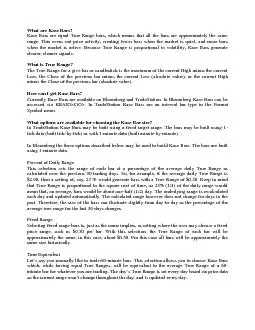

Kase Bars are equal True Range bars which means that all the bars are approximately the same range This evens out price activity creating fewer bars when the market is quiet and more bars when t ID: 824922
Download Pdf The PPT/PDF document "What are Kase Bars?" is the property of its rightful owner. Permission is granted to download and print the materials on this web site for personal, non-commercial use only, and to display it on your personal computer provided you do not modify the materials and that you retain all copyright notices contained in the materials. By downloading content from our website, you accept the terms of this agreement.
What are Kase Bars? Kase Bars are equa
What are Kase Bars? Kase Bars are equal True Range bars, which means that all the bars are approximately the same range. This evens out price activity, creating fewer bars when the market is quiet, and more bars when the market is active. Because True Range is proportional to volatility, Kase Bars generate clearer, cleaner signals. What is True Range? The True Range for a give bar or candlestick is the maximum of the current High minus the current Low, the Close of the previous bar minus the current Low (absolute value), or the current High minus the Close of the previous bar (absolute value). How can I get Kase Bars? Currently Kase Bars are available on Bloomberg and TradeStation. In Bloomberg Kase Bars can be accessed via KBARSGO&#x-500;. In TradeStation Kase Bars are an interval bar type in the Format Symbol menu. What options are available for choosing the Kase Bar size? In TradeStation Kase Bars may be built using a fixed target range. The bars may be built using 1-tick data (built tick-by-tick) or with 1-minute data (built minute-by-minute). In Bloomberg the three options described below may be used to build Kase Bars. The bars are built using 1-minute data. Percent of Daily Range This selection sets the range of each bar at a percentage of the average daily True Range as calculated over the previous 30 trading days. So, for example, if the average daily True Range is $2.00, then a setting of, say, 25 % would generate bars with a True Range of $0.50. Keep in mind that True Range is proportional to the square root of time, so 25% (1/4) of the daily range would mean that, on average, bars would be about one-half (1/2) day. The underlying range is recalculated each day and updated automatically. The calculated range however does not change for days in the past. Therefore, the size of the
bars can fluctuate slightly from day-
bars can fluctuate slightly from day-to-day as the percentage of the average true range for the last 30-days changes. Fixed Range Selecting fixed range bars is, just as the name implies, as setting where the user may choose a fixed price range, such as $0.50 per bar. With this selection, the True Range of each bar will be approximately the same, in this case, about $0.50. For this case all bars will be approximately the same size historically. Time Equivalent Let’s say you normally like to trade 60-minute bars. This selection allows you to choose Kase Bars which, while having equal True Ranges, will be equivalent to the average True Range of a 60-minute bar for whatever you are trading. The day’s True Range is set every day based on prior data so the current range won’t change throughout the day, and is updated every day. What if my time equivalent bar isn’t listed in Bloomberg? Plot the time bars you normally trade, along with the ATR indicator. Estimate the ATR from the plot, then, using the Fixed Range selection, set the range to the ATR to be the same as that plotted for your time bars. Why don’t all of my Kase Bars look the same? There could be two reasons for this. The first is that Kase Bars are built using one-minute bars. If the price action from one-minute to the next is more than the target range, then the bar will be larger than the target. This also includes any gaps between the last minute of one day and the first minute of the next. The second reason that the bars might not look equal is that gaps are included in the range, but are not necessarily drawn on the bar. The illustration below shows three bars all having a range of 5 cents. For the first two bars, the True Range is the High minus the Low, but for the third bar, it’s the High minus the previous close